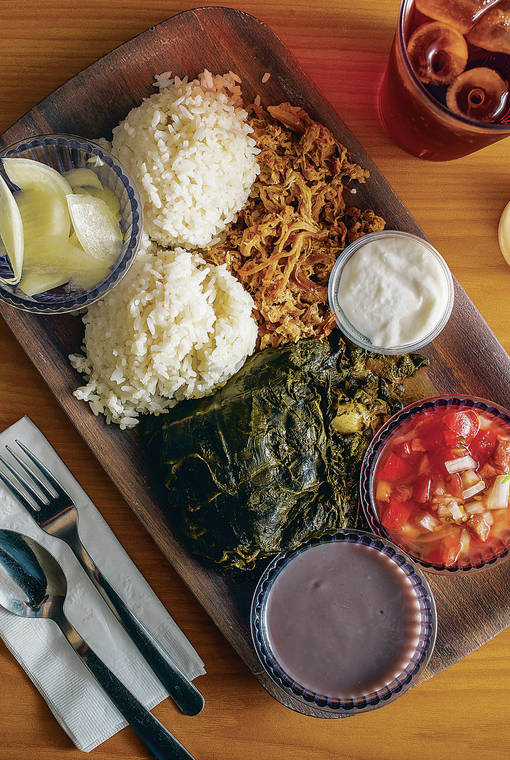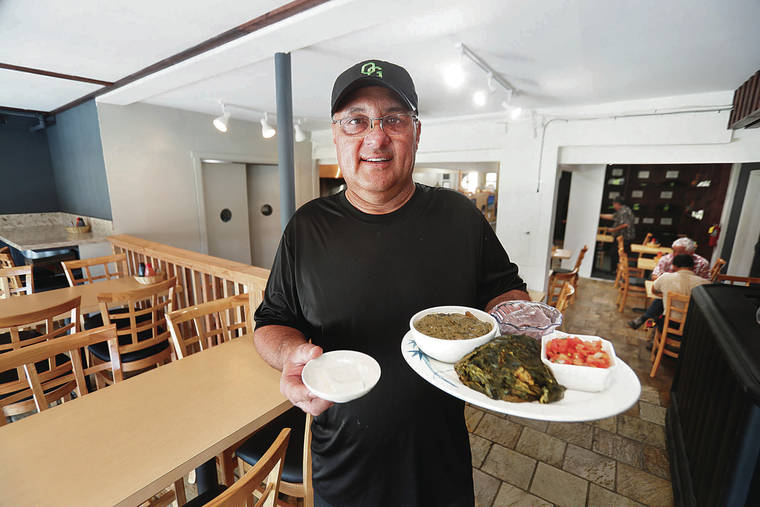The first times my insomniac friends try to text me at 3 a.m., they’re surprised to get a response. I’m kept awake by circular thoughts and worries about the sort of things no one else worries about.
One recent concern? Well, here we are in the birthplace of Hawaiian food, the only place that can legitimately claim it, yet the cuisine is under-represented in our restaurants.
Although simple in presentation, it is a labor-intensive cuisine with necessities such as luau leaves, ti leaves and dryland taro, not exactly stock ingredients. So I have to applaud anyone willing to make the attempt.
While locals know where to look for pockets of Hawaiian food, visitors to the islands would have difficulty finding this roots cuisine, and it seems such a shame to travel so far and not have a true taste of Hawaii.
Just as I was beginning to worry what might happen should our handful of Hawaiian food restaurants suddenly close, a miracle happened.
Over the past couple of months, two new restaurants offering Hawaiian fare and more, have appeared in Kaimuki, both rooted in family traditions.
KUHIO GRILLE
3036 Waialae Ave.; 732-2336
Open 10 a.m. to 8 p.m. daily (except Wednesdays); additional parking available in City Mill pay lot
Though united by history and culture, separation by ocean nevertheless resulted in some culinary differences among the islands. On Kauai, you might find smoked ahi sushi topped by raw shrimp, a combination I’ve never seen on Oahu. And on Hawaii Island, Hilo residents are said to really love gravy, which made it a logical place to give birth to the loco moco.
In Hilo, Kuhio Grille is known for its 1-pound laulau, but on this island, it’s most noteworthy for its laulau center of pork and beef, varying from the standard combination of pork and fish. Because the Big Island is cattle country, beef is most accessible, I reasoned. The real reason had nothing to do with history or socio- economics, but to personal preference.
“My grandma didn’t like fish,” explained Lauren Araki, who along with sisters Erin and Shannon run the new Kaimuki branch of the restaurant that opened in Hilo in 1995.
Their family’s food ties go back even further. The sisters grew up farming taro in Waipio Valley, on land their great- grandfather Genji Araki had farmed since the early 1900s, after finishing his sugar plantation contract. His first son, Tetsuo, took over the farm upon Genji’s retirement, and his wife, Sueno, started using extra taro leaves to make laulau for family and friends.
When Tetsuo retired in 1982, his sons Sam and Derrick continued the business. In 1995, Sam and his wife Nelline launched Kuhio Grille, which became known as the “home of the 1-pound laulau,” made from Sueno’s recipe.
That laulau can be ordered a la carte ($8.49), as a meal with rice and salad ($11.99), in various combos, or as the centerpiece of the Kanak Atak plate ($21.99) also featuring kalua pork, lomi salmon, pickled onions, poi and rice. The beef in the laulau is tender and, although I miss the salty quality of the fish it replaces, it was tasty enough to make me wonder why no one else does this on Oahu, where other ingredients like chicken and sweet potatoes have become standards.
At the restaurant, I learned there is more than one way to eat laulau. Silly me, I thought everyone slid their forks in, taking in elements of leaf and protein in one bite, maybe with a sprinkling of chili pepper water and/or bite of raw onion or poi.
Araki said she’s seen it eaten doused with mayonnaise or ketchup, or separated into mounds of greens and meat and eaten with rice, poi or mac salad as a multi-component meal. “That’s how I eat it,” she said. “I open it up, take out all the meat and eat the leaves first. That’s my favorite. That part soaks up all the flavor from the meat.”
Any plate can be upgraded with fried rice for $4.50 ($8.99 full order). The restaurant is also known for its saimin ($8.99), although I don’t like getting full on soup, so prefer dry fried saimin ($9.99).
The menu features a handful of plate lunch-style entrees, such as teriyaki-style yakitori chicken ($12.49), pork cutlet ($13.99) and hamburger steak ($11.99). And true to Big Island style, you can get a quarter-pound gravy burger oozing with brown gravy ($9.29). When available, a verdant squid luau is one of my favorites.
Some familiar with the restaurant have been disappointed that breakfast specialties such as taro corned beef hash and hotcakes are not on the menu, but the sisters are just getting started and aim to introduce breakfast early next year.
OAHU GRILL
Kaimuki Atrium, 1137 11th Ave.; 762-0130
Open 10:30 a.m. to 9 p.m. daily
Born in Waikane, John Adolpho said he was a kolohe boy whose mom shipped him off to Molokai to live with his uncle so he could get a distraction-free middle and high school education.
There, he learned a sense of responsibility and self-reliance. He had to.
“It’s hard to explain, but everybody on Molokai is a diver and hunter. Everybody still grows vegetables. It’s not an easy life. They still live off the land,” he said.
“There’s very few restaurants, so everyone cooks their own meals and they’re all good cooks. There’s no Chinese restaurant, so if you wanted to eat Chinese food, you have to learn how to make it yourself.”
In that environment, Adolpho learned to cook by helping his uncle and grandparents, learning all the fundamentals of the backyard luau.
Upon returning to Oahu, he found work in the construction industry, but became the go-to guy for family luau, earning the nickname “Chef Johnny.”
When his uncle Calvin Hoe, owner of Waiahole Poi Factory, needed help in the kitchen, Adolpho was there, although his wife urged him to open his own restaurant.
“It was not something I wanted to do, knowing how much work it is, but I was doing the work anyway, so I thought I might as well try to do it on my own.”
He said he chose Kaimuki to open Oahu Grill because it’s a diverse neighborhood that he believes mirrors the way Hawaii’s old plantations brought together a mix of Chinese, Japanese, Portuguese and Filipino laborers. It’s the kind of community that might appreciate his combination of Hawaiian and old-school, plantation- rooted cuisine.
Hawaiian food is sold a la carte here, at $12 for a pork-only laulau ($8 mini), kalua pork, coconut milk-saturated squid luau, lechon kawali or tripe stew. Chicken long rice is $11 ($7 mini). Salt meat watercress is $13 ($9 mini), with an abundance of the watercress chopped fine. I usually don’t like the bitterness of watercress, but as fresh as the cress is here, there’s not a trace of that bitterness.
From these entrees, you can create a two-item combination plate for $16, or three-combo plate for $20.
In addition, heart-warming, homey, plantation-style daily specials include ham hock soup ($12) on Saturdays, and pork squash soup ($12) on Sundays.
Adolpho’s chicken hekka ($11, Tuesdays) is nothing like what my Chinese mom used to make, with the basics of chicken, long rice, salt, pepper and green onions. Drawing from several plantation cultures, his hekka embraces Japanese shoyu and sugar, plus green beans and other vegetables from the Filipino garden. Cutting the noodles is just not done in Asian cultures, but mishaps are bound to happen when combining slippery noodles and broth, so I appreciate that Adolpho has cut the noodles into manageable lengths here. I have a tendency to wear some food home whenever noodles and sauce come together.
As a meat eater, I’m most drawn to the lechon and sweet-soy marinated smoked meat here. Just watch out for the plastic plates they’re served on. They look like weightier ceramic, so when a friend nearly flipped the light plate while reaching for a piece of meat, I just assumed it was because she’s a klutz. Then I did the same thing.
Nadine Kam’s restaurant reviews are conducted anonymously and paid for by the Star-Advertiser. Reach her at nkam@staradvertiser.com.




